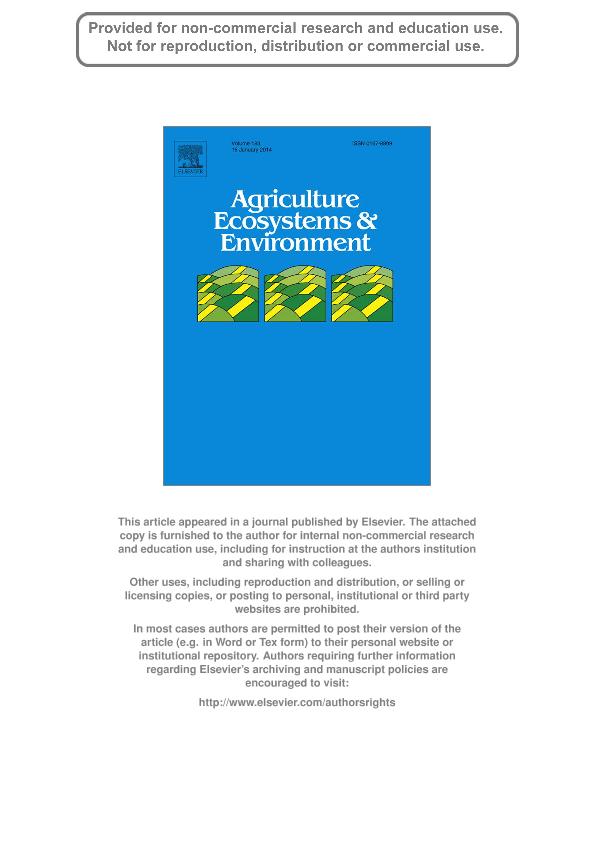Mostrar el registro sencillo del ítem
dc.contributor.author
D'acunto, Luciana

dc.contributor.author
Semmartin, María Gisela

dc.contributor.author
Ghersa, Claudio Marco

dc.date.available
2016-02-11T19:45:15Z
dc.date.issued
2014-01-15
dc.identifier.citation
D'acunto, Luciana; Semmartin, María Gisela; Ghersa, Claudio Marco; Uncropped field margins to mitigate soil carbon losses in agricultural landscapes; Elsevier; Agriculture, Ecosystems and Environment; 183; 15-1-2014; 60-68
dc.identifier.issn
0167-8809
dc.identifier.uri
http://hdl.handle.net/11336/4146
dc.description.abstract
Agricultural intensification is a major cause of habitat transformation. Continuous cropping alters ecosystem services, such as biodiversity and carbon sequestration. Empirical evidence from agricultural lands in Argentina has shown that permanently vegetated areas imbedded in the agricultural matrix (uncropped margins) play a critical role in plant and animal communities compared to the usual situation of crops surrounded by other crops (cultivated margins). However, the potential impact of uncropped margins on their own carbon stocks and fluxes and on those of their neighbouring cropped fields remains unknown. We investigated the impact of uncropped (herbaceous and woody) and cropped margins (cultivated fields) on their own topsoil carbon stocks and fluxes and on those of their neighbouring croplands (soybean fields). We identified soybean fields adjacent to one of three possible margin types: herbaceous or woody permanent vegetation, and field crop, which acted as control because it is the most frequent situation in the region. In each of these margin?soybean pairs, we sampled transects from the margin towards the centre of the soybean field (50 m). Woody margins showed the greatest soil carbon content, the least decomposable plant litter and the greatest influence on the neighbouring crop. Conversely, herbaceous margins had the lowest litter accumulation and the most decomposable litter. Only woody margins influenced soil properties in the first metres of the cropped neighbourhood. Centres of soybean fields were similar, irrespective of margin type. The decomposition of common substrates was not affected by margin type. These findings suggest that woody margins are the unique element of the current landscape with a potential to mitigate soil carbon loss from agroecosystems, albeit spatially limited. In contrast, the low biomass and highly decomposable litter of herbaceous margins reveal the urgent need to re-think their current management strategies.
dc.format
application/pdf
dc.language.iso
eng
dc.publisher
Elsevier

dc.rights
info:eu-repo/semantics/openAccess
dc.rights.uri
https://creativecommons.org/licenses/by-nc-nd/2.5/ar/
dc.subject
Agricultural Intensification
dc.subject
Field Margins
dc.subject
Decomposition
dc.subject
Pampas
dc.subject.classification
Agricultura

dc.subject.classification
Agricultura, Silvicultura y Pesca

dc.subject.classification
CIENCIAS AGRÍCOLAS

dc.title
Uncropped field margins to mitigate soil carbon losses in agricultural landscapes
dc.type
info:eu-repo/semantics/article
dc.type
info:ar-repo/semantics/artículo
dc.type
info:eu-repo/semantics/publishedVersion
dc.date.updated
2016-03-30 10:35:44.97925-03
dc.journal.volume
183
dc.journal.pagination
60-68
dc.journal.pais
Países Bajos

dc.journal.ciudad
Amsterdam
dc.description.fil
Fil: D'acunto, Luciana. Consejo Nacional de Investigaciones Científicas y Técnicas. Oficina de Coordinación Administrativa Parque Centenario. Instituto de Investigaciones Fisiológicas y Ecológicas Vinculadas a la Agricultura; Argentina
dc.description.fil
Fil: Semmartin, María Gisela. Consejo Nacional de Investigaciones Científicas y Técnicas. Oficina de Coordinación Administrativa Parque Centenario. Instituto de Investigaciones Fisiológicas y Ecológicas Vinculadas a la Agricultura; Argentina
dc.description.fil
Fil: Ghersa, Claudio Marco. Consejo Nacional de Investigaciones Científicas y Técnicas. Oficina de Coordinación Administrativa Parque Centenario. Instituto de Investigaciones Fisiológicas y Ecológicas Vinculadas a la Agricultura; Argentina
dc.journal.title
Agriculture, Ecosystems and Environment

dc.relation.alternativeid
info:eu-repo/semantics/altIdentifier/url/http://www.sciencedirect.com/science/article/pii/S0167880913003629
dc.relation.alternativeid
info:eu-repo/semantics/altIdentifier/doi/http://dx.doi.org/10.1016/j.agee.2013.10.022
dc.relation.alternativeid
info:eu-repo/semantics/altIdentifier/issn/0167-8809
Archivos asociados
